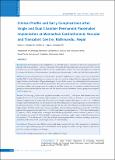Please use this identifier to cite or link to this item:
https://hdl.handle.net/20.500.14356/1750| Title: | Clinical Profile and Early Complications after Single and Dual Chamber Permanent Pacemaker Implantation at Manmohan Cardiothoracic Vascular and Transplant Centre, Kathmandu, Nepal |
| Authors: | Khanal, J Poudyal, R R Devkota, S Thapa, S Dhungana, R R |
| Citation: | KhanalJ., PoudyalR. R., DevkotaS., ThapaS., & DhunganaR. R. (2015). Clinical Profile and Early Complications after Single and Dual Chamber Permanent Pacemaker Implantation at Manmohan Cardiothoracic Vascular and Transplant Centre, Kathmandu, Nepal. Journal of Nepal Health Research Council. https://doi.org/10.33314/jnhrc.v0i0.638 |
| Issue Date: | 2015 |
| Publisher: | Nepal Health Research Council |
| Article Type: | Original Article |
| Keywords: | Complication Permanent pacemaker implantation Nepal |
| Series/Report no.: | May-Aug, 2015;638 |
| Abstract: | Abstract Background: Permanent pacemaker implantation is a minimally invasive surgical procedure in the management of patients with cardiac problems. However, complications during and after implantation are not uncommon. There is lack of evidences in rate of complications with the selection of pacemakers in Nepal. Therefore, this study was performed to compare the frequency of implantation and complication rate between single chamber and dual chamber pacemaker. Methods: The present study is based on all consecutive pacemaker implantations in a single centre between April 2014 and May 2015. A total of 116 patients were categorized into two cohorts according to the type of pacemaker implanted-single chamber or dual chamber. All patients had regular 2-weeks follow-up intervals with standardized documentation of all relevant patient data till 6-week after implantation. Data were presented as means ± standard deviation (SD) for continuous variables and as proportions for categorical variables. Comparison of continuous variables between the groups was made with independent Student’s t-test. For discrete variables distribution between groups were compared  with Chi-square test. Results: The mean age (±SD) of total population at implant was 64.08 (± 15.09) years. Dual chamber units were implanted in 44 (37.93%) of patients, single chamber in 72 (62.06%). Only 14 women (31.81%) received dual chamber compared with 42 women (58.33%) who received single chamber (Chi-square=18, DF=1, P = 0.0084). Complete atrioventricular block was the commonest (56.03%) indication for permanent pacemaker insertion followed by sick sinus syndrome (33.62%), symptomatic high-grade AV block (11.20%). Hypertension (dual chamber 21.55%, single chamber 40.51%) was the most common comorbidity in both cohorts. Complications occurred in 11 (9.48%) patients. More proportion of complication occurred in single chamber group (9 patients, 12.50%) than in dual chamber (2 patients, 4.54%). Complications occurring in dual chamber group include pocket hematoma 1 patient (2.27%) and arrhythmia in 1 patient (2.27%). Similarly, complications occurring in single chamber include RV perforation in two patients (2.77%) and one each (1.38%) had pocket hematoma, pneumothorax, infection, swelling at pocket site, arrhythmia in the form of NSVT, leads displacement, DVT and mortality. Conclusions: Women were more likely to receive single chamber systems than men. More proportion of complication occurred in single chamber group than in dual chamber. Future prospective studies on larger number of patients are needed to confirm and support our findings. Keywords: Complication; permanent pacemaker implantation; Nepal. |
| Description: | Original Article |
| URI: | http://103.69.126.140:8080/handle/20.500.14356/1750 |
| ISSN: | Print ISSN: 1727-5482; Online ISSN: 1999-6217 |
| Appears in Collections: | Vol. 13 No. 2 Issue 30 May - August 2015 |
Files in This Item:
| File | Description | Size | Format | |
|---|---|---|---|---|
| 638-Article Text-1174-2-10-20160104.pdf | Fulltext Download | 229.22 kB | Adobe PDF |  View/Open |
Items in DSpace are protected by copyright, with all rights reserved, unless otherwise indicated.
